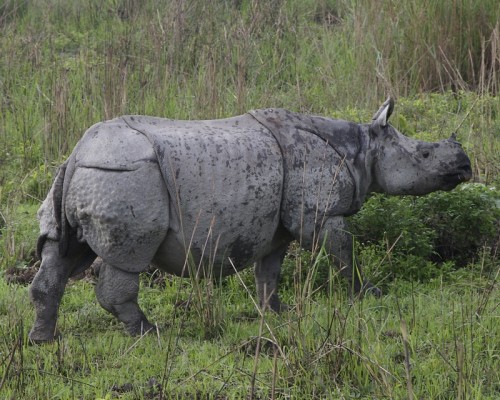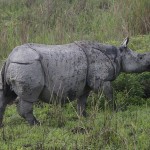
At least 26 greater one-horned rhinos have already been massacred for their horns in the Indian state of Assam during the first five months of 2013.
The tally now exceeds 2012’s total of 21 rhinos gunned down in Assam. And there is yet another threat to the vulnerable pachyderms: The annual monsoon season, which begins in June and ends in September. Last year, at least 28 rhinos drowned. Rising floodwaters also force the rhinos out into the open as they seek higher ground, which makes them even easier targets for rhino-killing gangs. However, it is hoped that deployment of camera-equipped unmanned aerial vehicles (UAV) will help monitor Kaziranga during the flooding.
As of March 30, 17 rhinos had reportedly been killed in Assam since the beginning of the year. Most recently, a male rhino was found dead with his horn missing on May 30 in Kaziranga National Park, near Kanchanjuri in the Bagori range of the park. Forest officials found “several empty cartridges of AK-47 and .303 rifles” near the rhino’s body. A female rhino had been gunned down just a week earlier near Dhanbari in the Agratoli range, where NDTV reported that three spent AK-47 cartridges were found.
A rifle was recovered on May 21 in Kaziranga National Park, thanks to a tip-off which prompted a joint operation by the Forest Battalion Force, India Reserve Battalion (IRB) and Assam Police. The illegal firearm was found “wrapped in a gunny bag and hung on a tree near Lal Dapu area”, according to the Times of India. The rifle recovery followed the arrest of two members of a rhino killing gang over the May 18 weekend. The suspects were identified by the Business Standard as Naren Doley and Bimal Pegu. A .303 rifle was deized from the duo.
On May 12, a male rhino was discovered dead in the Doramari area of the park. The rhino was believed to have been dead for at least four days. A day earlier, two dead rhinos with missing horns were found near Borkata in the Bagori range, and the other near Noloni in the Agaratoli range.
The people who are working to protect Assam’s rhinos are also at risk. On May 5, two men from the Assam Forest Protection Force battalion were seriously injured in an exchange of gunfire with a rhino killing gang in Kaziranga National Park. The incident occurred in the Burapahar range.
Despite the fact that wildlife trafficking is a threat to global security, suspects are generally granted bail and convictions remain nearly nonexistent. A forest official who asked not to be identified told the Assam Tribune that “the Wildlife (Protection) (Assam Amendment) Act, 2009, has made poaching of Schedule I and Part II of Schedule II species a non-bailable offence. However, poachers often get bail even after committing the crime”.
Thirty-six suspected poachers have been arrested this year and 141 in 2012. However, the conviction rate is almost zero in most of the cases.
Assam is home to 70 percent of the world’s greater one-horned rhinos, a species which has recovered from near extinction to more than 3,000 today.
Learn more:




